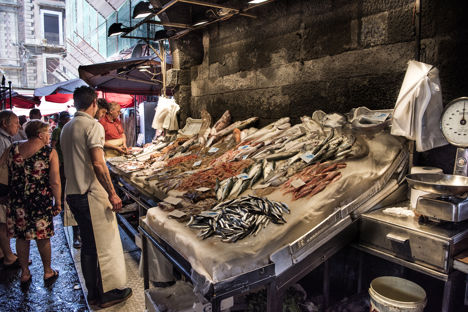
Pesce crudo: Sicily’s love for raw fish
Marisa Raniolo Wilkins looks at the rising popularity of this simple, ceviche-style way of eating on the beautiful island of Sicily.
Raw fish tends to be associated with certain countries that enjoy long and winding coastlines, plenty of beautiful sunshine and a strong fishing culture. The Japanese have sashimi and the Peruvians have ceviche, but anyone wanting to tuck into the delicacy in Europe should make the trip to Sicily for its incredible pesce crudo (literally ‘raw fish’). Along with arancini, it’s the quintessential Sicilian dish to tuck into from the comfort of a beautiful villa, bathed in sunshine whilst looking out onto the azure clean waters – a truly unforgettable experience.
Most of us associate raw fish with soft, melting slices of tuna and it’s often named as the most popular species to eat fresh and uncooked – especially in Japan. Sicilians are mad for tuna, too, and they eat the whole fish, from lips to fin tips, making the most of the cheaper cuts of dark red meat to the most expensive fillets from the lowest part of the belly next to the head. In May, tuna lovers from all over the world head to Favignana to see the mattanza, where Sicilian fishermen join forces to cast a complex system of nets to catch particularly large bluefin tuna, which are in high demand in places like Japan. And Sicily's coastline is still dotted with tonnare – historic tuna fisheries where special chamber traps were used to guide fish to shore, before they were killed and prepared for sale. Many are no longer operational, but those in places like Scopello and Marzamemi can be visited and offer a fascinating insight into the island's history.
But whether you eat pesce crudo in Catania or sashimi in Tokyo, it is essential that the raw fish be freschissimo – extremely fresh – ideally, as freshly caught as possible. Sicily is surrounded by sea; the Mediterranean laps along Sicily’s west and south coasts, the Ionian Sea lies to the east and the Tyrrhenian Sea rolls onto the north. This makes sourcing freshly caught, local and seasonal fish easy, and buying some at the local market should be at the top of any holidaymaker’s list.
Fish markets and marinas
Walking through the fish markets in Sicily is always a joy; the hustle and bustle of locals seeking out the best produce among the colourful stalls and traders is what makes the island such a charming place. There is more than one fish market in Catania, but the principal market in the southwest of the Cathedral Square is one of the largest in Sicily. However, wherever you are on the island will never be too far from fresh fish.
Sicily’s fish markets have vast, colourful, varied displays of exotic specimens such as sea urchins and edible algae to the more conventional squid, octopus, tuna and swordfish. Small, live fish swim circles in buckets of sea water, snails crawl about and all types of shellfish, especially the gamberi rossi (red prawns) of Sicily, look dazzling. You know the fish is fresh – their shells and scales glisten in the sun.
Swordfish and tuna, the traditional staples of Sicilian cuisine, are the centrepieces of the market stalls. They are often displayed whole, the swordfish bill like a spear thrusting upwards. At other times, their massive round carcasses lie like a trunk on the fishmonger’s bench, while the tuna is sliced vertically and horizontally before being filleted along the length of its spine, while all its parts are laid out, testifying to its freshness.
Nothing is wasted. Each part is available to be eaten raw, grilled, smoked or salted. Two of the Sicilian specialties introduced by the Arabs over a thousand years ago were bottarga and mosciame. Bottarga is the roe in the ovary sacs of female tuna. This is pressed into a solid mass, salted and dried. Bottarga is highly valued and used sparingly and grated to impart an intense fishy flavour. Mosciame is salted tuna and its firm, deep red-brown flesh needs only paper-thin slicing. It is usually eaten softened in oil with a sprinkling of lemon juice. Both strongly flavoured specialities are often part of the fish antipasti on offer.
Fishing has always been a vital part of the cuisine and economy of Sicily, with locals preparing a variety of seafood on a daily basis. Pesce crudo is one of the most popular ways to serve the daily catch because the recipe requires very little effort and can be created from almost any fish. Yet despite its simplicity, this local delicacy is the best way to taste the freshness of what’s on offer in the markets. Just like a Sicilian, you can simply buy some fish in the morning, leave it to marinate throughout the day at your villa and then come back and eat it after a few hours exploring the island, perhaps with a glass of cold white wine – an easy way to experience the unique flavours of the island.
In the ports of the larger towns you will see the bigger fishing boats moored during the day. These are usually part of a fishing fleet, but there are also the many smaller, colourful traditional fishing boats that come in and out of the bays and marinas to unload and sell their small catch of fish on the wharf. The vividly coloured boats of Syracuse are particularly active and in Marina di Ragusa small traditional fishing boats putter in and out of the marina day and night, their catch sold in the mornings on the beach. Here too, as in the larger fish markets, you will enjoy the laughter and penetrating voices of the buyers and sellers, haggling over the price of fish, mostly conducted in Sicilian punctuated with hand gestures. It’s a pleasure to just sit back and watch the locals at work, immersing yourself in the island’s culture and daily life.
A perfect demonstration of how Sicilians used to treat raw fish is by an old traditional speciality dish called Mascolini cruri (in Italian) or Anchiva cruri (in Sicilian), a particular recipe from Catania. Sardines, anchovies and mascolini (a variety of small anchovy) are caught along the coast of Etnea. In Catania's hyperactive fish market, it is not unusual to see the sardine catch still twitching. The fresh anchovies are gutted, cleaned and have their heads removed. They are then left in lemon juice for at least a few hours. Sometimes, the anchovies are referred to in Sicilian as anchiva cotti d’a lumia, that is, anchovies cooked by the lemon juice, and that is exactly what has happened – the citric acid in the marinade has done the cooking. The anchovies are then drained and dressed with a drizzle of extra virgin olive oil, some freshly sliced chilli, chopped parsley, crushed garlic and a little salt. The fish cures much like ceviche.
When it comes to the more modern version of pesce crudo, the olive oil plays a much more important part. Intensely scented, fruity and herbaceous, it will often come from Sicily itself – all over the island you can spot aged olive trees over 100 years old, still harvested by the locals for some of the best oil in Italy. If you want to try and recreate the flavour of a proper Sicilian pesce crudo at home (although it never really tastes as good once you’ve had it on the island itself), then a few bottles of Sicilian olive oil straight from the source are a must.
Culinary evolution
The desire for new and more exotic foods is never-ending and, as with other cultures, Sicily has adapted its cuisine to pursue the quest and move with the times. Historically, the seas around Sicily teemed with tuna and swordfish – the two most highly prized fish in Sicilian cuisine – but the highly industrialised fishing of these two species has resulted in plummeting stocks. So, it is heartening to see other varieties of fish offered as pesce crudo on menus, which gives these fish a chance to recover and grow to full size.
Today, pesce crudo can be made from all sorts of fish or seafood, so long as it is of the highest quality and visually appealing (which most of the fish caught on the island is). Filleted fish, sea urchins, squid, octopus, prawns (especially red prawns) and scampi are now commonplace. Sardines and anchovies (which are now usually filleted rather than served whole) are still favourites too.
Expect a creative garnish or two with local Sicilian flavours to characterise the raw dishes as well – the fruit, juice and grated peel of any of the citrus fruit (especially blood oranges), capers, olives, salted anchovies and fresh herbs. In Sicily they like to use mint, oregano, basil, fennel, chilies, almonds or pistachios. There may be slivers of vegetables or other fruit, too, such as strawberries or prickly pear. However, at the heart of any good pesce crudo is a fantastic piece of unbelievably fresh fish, sourced from the local market on a sunny day and taken home to gently cure in citrus juice before being enjoyed on a relaxing afternoon. You might have access to the same ingredients anywhere else in the world, but there’s something special about eating the dish under the Sicilian sun – and that simply can’t be recreated.



